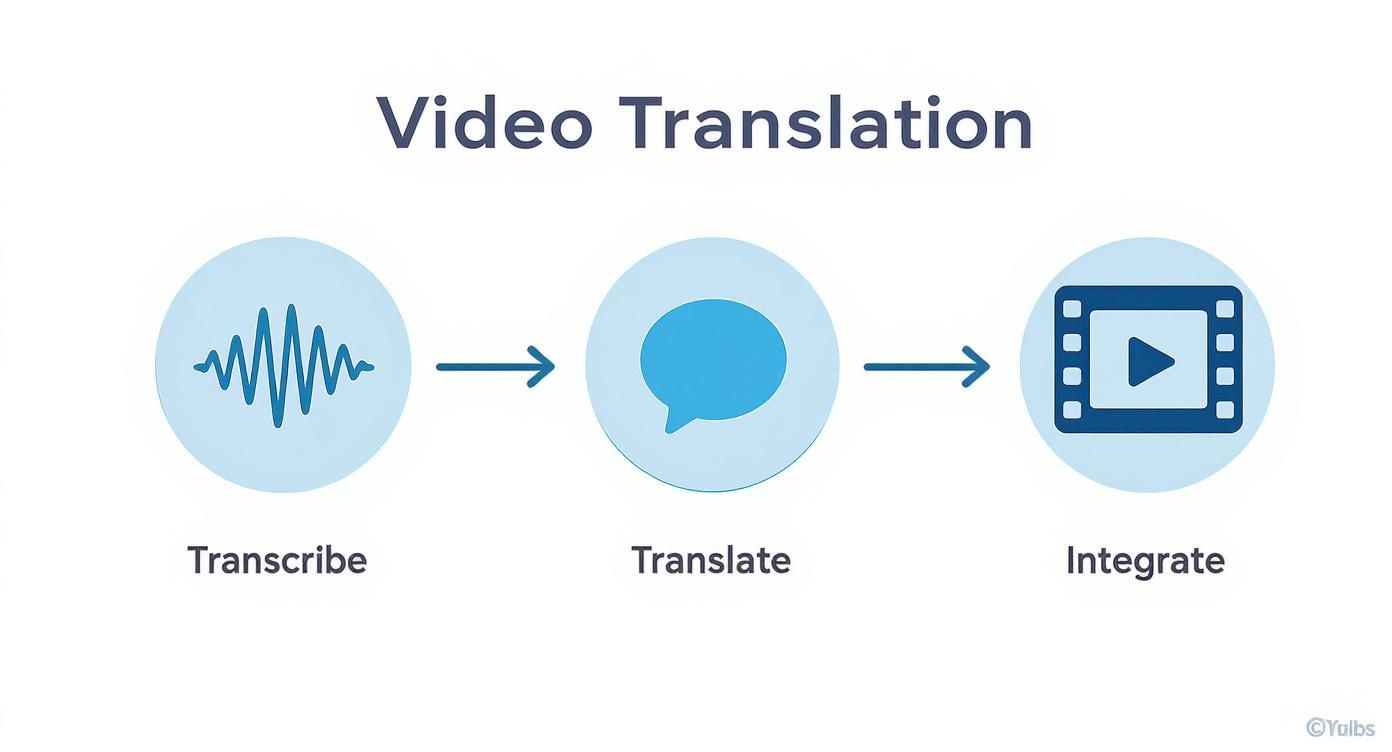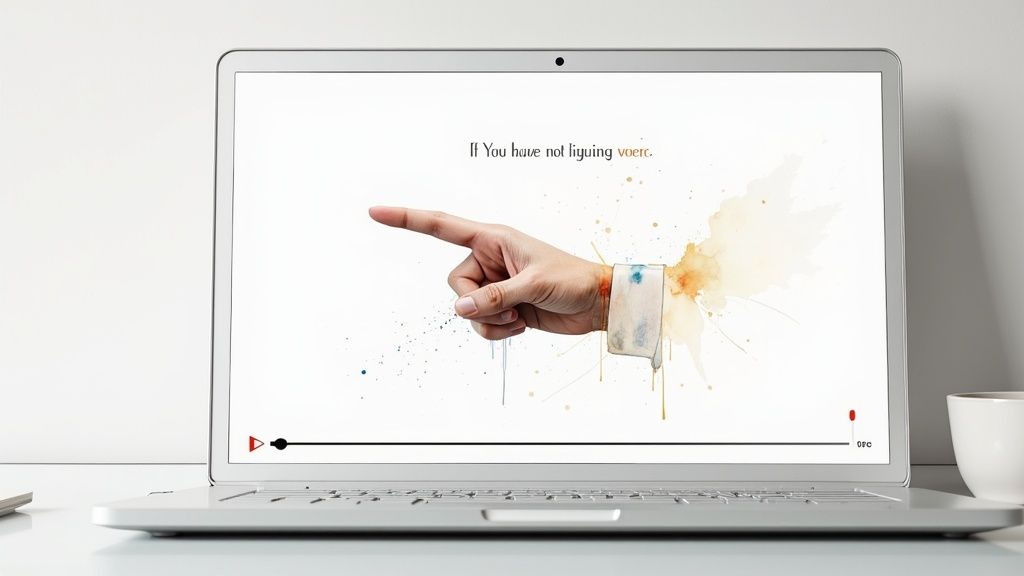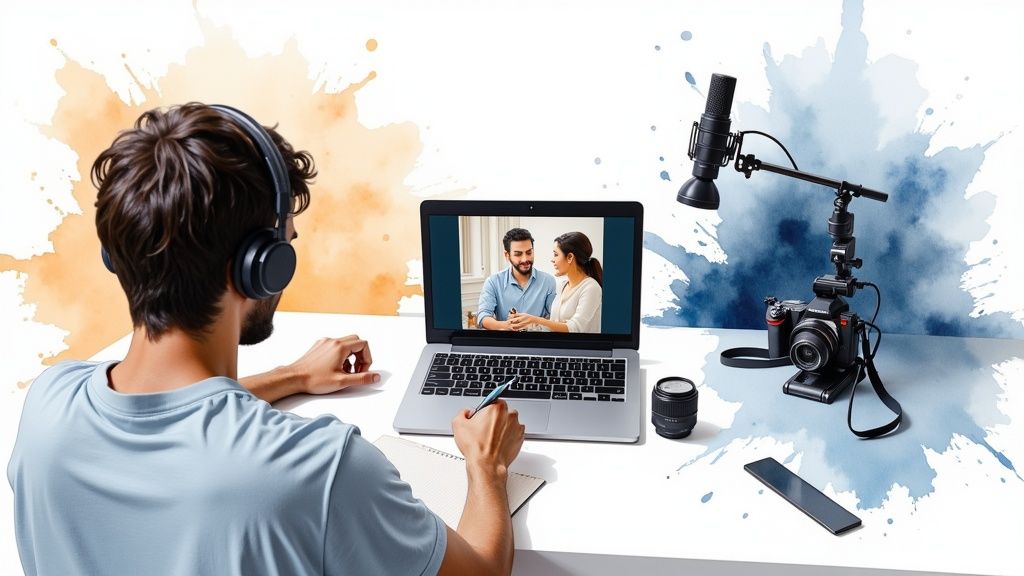how to translate a spanish video to english: A practical, step-by-step guide to translating dialogue for accurate subtitles and wider reach.
In This Article
Subscribe to our newsletter
So you have a great video in Spanish and want to bring it to an English-speaking audience. What’s the best way to do that?
The whole process boils down to a clear, three-part workflow. First, you get a perfect Spanish transcript. Next, you translate that text into natural-sounding English. Finally, you have to get that translation back into the video, either as subtitles or a full voice-over.
Your Practical Video Translation Roadmap
Breaking into a new market means adapting your content, and translating your Spanish video is one of the smartest moves you can make. But it's not just about swapping out words. The real goal is to carry the original message's heart, tone, and cultural flavor over to a whole new audience.
Understanding the path from a Spanish original to a polished English version helps you make better decisions, whether you're a one-person team on a tight budget or a studio aiming for broadcast quality.
Core Stages of Video Translation
Every video translation project, big or small, follows the same fundamental steps. You can see the entire flow laid out here.

As you can see, the process moves logically from transcription to translation and finally to integration. Each stage builds directly on the one before it, so getting the early parts right is crucial.
This isn't just a niche skill anymore; it's a booming industry. The global AI video translation market hit USD 2.68 billion in 2024, with North America leading the pack. This growth is all thanks to tech that makes reaching global audiences easier than ever.
Core Translation Methods at a Glance
Here's a quick comparison of the primary methods for translating video content to help you decide which approach fits your project's needs and budget.
| Method | Best For | Pros | Cons |
|---|---|---|---|
| Subtitles | Social media, e-learning, content where the original speaker's voice is important. | Cost-effective, fast turnaround, accessible for viewers in noisy environments. | Can be distracting, may not capture the full emotional tone of the original audio. |
| AI Voice-Over | Internal training, quick informational videos, budget-conscious projects needing a spoken translation. | Very fast, low cost, consistent voice quality. | Can sound robotic, lacks human emotion and intonation. |
| Human Voice-Over | Marketing videos, films, documentaries, high-production content where viewer immersion is key. | Authentic emotion, natural delivery, high-quality viewer experience. | Expensive, time-consuming, requires professional talent and studio setup. |
Choosing the right method upfront will save you headaches down the road and ensure the final product connects with your intended audience.
Key Decisions in Your Workflow
Before you start, a few key choices will shape your project's outcome. Thinking these through now will save you a ton of time and make sure you love the final result.
- AI vs. Human Touch: Are you going to rely on automated tools for speed, or bring in human experts for their nuance and cultural understanding? I’ve found a hybrid approach—AI for the heavy lifting, human for the final polish—often delivers the best of both worlds.
- Subtitles vs. Dubbing: Will on-screen text do the trick for your audience? Or does your content need a full English voice-over to create a truly immersive experience?
- Localization Depth: A simple translation changes the words. True localization goes deeper, adapting cultural references, idioms, and even on-screen visuals. To make sure your video truly hits home, you’ll want to explore effective content localization strategies that go far beyond just words.
A successful video translation isn't just about swapping languages. It's about recreating the original experience for a new audience, and that requires a solid plan for your transcription, translation, and final delivery.
Right, before you can even think about translating a Spanish video into English, you need a word-for-word script of what’s being said. This transcript is the foundation for everything that follows.
Think of it this way: any mistake here—a misheard word, a wonky timestamp—is going to snowball. You’ll end up backtracking later, fixing problems that were totally avoidable. It’s a huge time-sink.
Getting this foundation right from the get-go means making a smart choice about your transcription method. You’ve really got two paths: let an AI service handle it, or have a human do it manually. Each has its place, and the best choice really comes down to the specifics of your video.
AI Transcription for Speed and Scale
For a lot of projects, AI-powered transcription is a brilliant first pass. Tools like the one built into Aeon can spit out a full, time-coded transcript in a matter of minutes. Seriously, it's fast.
If your video is pretty straightforward—say, a single speaker with clear audio, like a product demo or a simple tutorial—an AI transcript can easily hit 90-95% accuracy. It’s incredibly efficient. It takes the most tedious part of the job off your plate, leaving you with a solid draft that just needs a quick polish. For content teams churning out a high volume of videos, that kind of speed is a game-changer.
When You Absolutely Need a Human Touch
But AI is far from perfect. Its accuracy can take a nosedive when things get complicated. You’ll absolutely need a human to step in—or even handle the whole thing from scratch—if your video has any of these elements:
- Multiple Overlapping Speakers: AI gets completely lost when people start talking over each other. A human transcriber can untangle the conversation and correctly label who said what.
- Heavy Accents or Regional Slang: Spanish isn't a monolith. An AI trained on Castilian Spanish might totally butcher slang from Chile, a thick Argentinian accent, or Caribbean colloquialisms.
- Poor Audio Quality: Background noise, a crackling mic, or quiet speakers will confuse an algorithm, leading to gibberish or huge gaps in the text. Humans are much better at parsing messy audio.
- Technical or Niche Jargon: If you’re dealing with specialized topics like medical procedures or complex engineering, you need a human expert. An AI simply won't know the difference between the correct and incorrect technical terms.
A clean transcript is a non-negotiable first step. I can't stress this enough. Investing time here to iron out every error, whether it’s from an AI tool or a manual job, will save you a world of hurt during the translation and subtitling phases.
Polishing Your Transcript for Translation
Whether you started with an AI draft or a human one, the final step is a thorough review. And I don’t mean just skimming for typos. You need to listen to the original Spanish audio while reading along with the transcript.
Your mission is to nail three key things:
- Speaker Identification: Make sure every line is attached to the right person. Use consistent labels like "Interviewer," "Maria," or "Expert 1."
- Timestamp Accuracy: Check that the timestamps line up perfectly with the spoken words. This is absolutely critical for creating properly synced subtitles later on.
- Cultural Nuances: This is where a human eye is essential. You need to catch and correct any misheard slang or culturally specific phrases an automated tool would miss. A simple phrase like "¿Mande?" might be transcribed literally, but in its Mexican context, it’s a polite "What?" or "Excuse me?" that needs to be understood correctly.
Once your Spanish transcript is flawless, you’re ready to go. You now have the solid raw material you need to create a truly compelling and accurate English version of your video.
Translating Text Without Losing Meaning

Alright, you've got a perfect Spanish transcript. Now comes the make-or-break moment where your message either connects with a new audience or gets hopelessly lost in translation. This is where we go beyond simple word-swapping and get into true localization, making the English version feel just as authentic as the original.
Let's be clear: modern AI translators, like the one built into Aeon, are incredibly good starting points. They’re a world away from the clunky tools of the past. These platforms understand context, sentence structure, and even basic tone, spitting out a solid first draft in seconds.
This initial AI pass is a massive time-saver. It gives you a complete English script to work from, saving you from the slog of manual translation.
The Irreplaceable Human Touch
But here's the thing: no AI can perfectly capture human nuance. Just running the script through a machine and calling it a day is a classic rookie mistake, one that usually results in awkward phrasing and cultural blunders. A human review isn't just a suggestion; it's a non-negotiable quality control step.
Take a common Spanish phrase like "estar en las nubes." An AI might translate this literally as "to be in the clouds," which sort of works. But what a native English speaker would actually say is "to have your head in the clouds." It’s these subtle, natural-sounding tweaks that elevate a translation from amateur to professional.
Key Takeaway: Think of AI as doing 80% of the heavy lifting, giving you a structurally sound translation. That last crucial 20%—the part that involves cultural adaptation, humor, and idiomatic language—absolutely requires a skilled bilingual human. This hybrid approach delivers professional results without blowing your budget.
The video translation software market is exploding, driven by AI advancements and audiences that demand high-quality localization. This isn't just about dubbing anymore; it includes subtitles and voice-overs, all critical for global content. As this trend continues, the blend of AI speed and human expertise becomes the gold standard.
Polishing the AI's Work
When you hand the script off to a human reviewer, their job is much bigger than just spotting typos. They are there to bridge the cultural gap that technology simply can't.
Here’s a practical checklist to give your reviewer:
- Idioms and Slang: Did the AI translate Spanish idioms literally? A phrase like "no tener pelos en la lengua" should become "to not mince words," not the bizarre "to not have hairs on the tongue."
- Cultural References: Are there mentions of Spanish celebrities, historical events, or local spots that will fly over the heads of an English-speaking audience? These might need a culturally relevant equivalent or a quick explanation.
- Tone and Formality: Does the English text match the original speaker's vibe? A casual, friendly Spanish conversation shouldn't be twisted into stiff, formal English.
- Subtitle Conciseness: If you're creating subtitles, is the text short and punchy? Spanish sentences can be longer than their English counterparts. Lines often need to be trimmed to fit on-screen reading times without losing their meaning.
By combining the raw speed of AI with the irreplaceable insight of a human editor, you can confidently translate your video from Spanish to English. The end result won't just be accurate; it will be genuinely resonant.
Creating and Syncing English Subtitles
https://www.youtube.com/embed/c2DFg53Zhvw
Alright, with your polished English script ready to go, it's time to get those words on the screen. Creating and syncing subtitles is more of an art than a science, really. You’re trying to find that perfect balance between readability and precise timing. This isn't just a copy-paste job; it's about making the whole experience feel natural for the viewer.
The end goal here is to create a standard subtitle file, usually an .SRT (SubRip Text) file. It’s a simple text file that holds three key things for each subtitle: a number, a start and end timestamp, and the text itself. The good news is that pretty much any video editing software, including platforms like YouTube, plays nicely with this format.
Breaking Down Your Text for Readability
First things first, you need to chop up that translated English script into bite-sized chunks that work on screen. No one can read a massive paragraph while also trying to follow the action in the video. You have to put yourself in the viewer's shoes.
Here are a few core principles I always follow for good subtitle segmentation:
- Character Limits: I stick to a maximum of 42 characters per line. This is a widely accepted industry standard that keeps the text from hogging the screen.
- Two-Line Maximum: Never, ever go over two lines for a single subtitle. Anything more just looks cluttered and becomes a nightmare to read quickly.
- Reading Speed: A good rule of thumb is to leave a subtitle on screen just long enough for someone to read it twice at a normal pace. For a full two-line subtitle, that usually falls somewhere between 4 and 7 seconds.
The demand for this kind of work is exploding. The global language services market is seeing massive growth, and it’s being driven by the need for multilingual content just like this. The industry is projected to hit USD 75.7 billion by 2025, with video translation being a huge piece of that pie. You can get more of the nitty-gritty details in Slator's 2025 Language Industry Market Report.
To Burn or Not to Burn Your Subtitles
Once your .SRT file is created and timed to perfection, you’ve got a big decision to make: do you "burn" the subtitles right into the video file, or do you offer them as a separate track?
Burned-in subtitles (also called open captions) are baked right into the video image. Viewers can't turn them off. This is my go-to for social media platforms like Instagram or TikTok, where videos often autoplay on mute. You have to guarantee the text is visible from the get-go.
Pro Tip: Burning in your subtitles gives you complete creative control. It ensures your text's font, size, and style look exactly how you want them to on every platform, which is a big deal for maintaining brand aesthetics.
On the flip side, selectable subtitles (or closed captions) are separate files you upload alongside your video on platforms like YouTube or Vimeo. This lets viewers toggle them on or off. It's the standard for accessibility and gives people more control, which is always a good thing.
Simple Styling for Maximum Clarity
If you do decide to burn in your subtitles, styling is key. Don't worry, you don’t need to be a graphic designer—the focus here is purely on legibility.
A classic, can't-go-wrong style is white text with a thin black outline or a semi-transparent black background box. This combination makes your English subtitles pop and stay perfectly readable against any background, whether it’s a bright, sunny scene or a dark, moody shot. It’s a small detail that makes a world of difference in how professional your final video looks.
Going a Step Further: AI Dubbing and Voice-Overs

Subtitles are a fantastic tool, but let's be honest—nothing beats a full English audio track for creating a truly immersive experience. This is where AI dubbing and voice-overs completely change the game. We're moving beyond just text on a screen to replace the original Spanish audio entirely.
Modern tools can generate a complete English audio version of your video, and the results are often shockingly natural. This isn't the clunky, robotic stuff of a few years ago. The technology has leaped forward, giving creators scalable solutions that used to require a professional studio and a hefty budget.
AI-Powered Voice Cloning: The High-Tech Approach
One of the most exciting developments in this space is AI voice cloning. This is where things get really interesting. The tech analyzes the original Spanish speaker’s voice—everything from their pitch and pacing to their unique vocal quirks—and then creates a synthetic English voice that is a near-perfect match.
Just imagine your video's narrator, with their distinct and trusted tone, now speaking flawless English. It's a powerful way to preserve the authentic feel of your content, which is a huge win for keeping your audience hooked. If you're curious about the nuts and bolts behind this, it's worth understanding how large language models (LLMs) work.
This method is a perfect fit for:
- Branded Content: It ensures your brand's voice stays consistent, no matter the language.
- Documentaries: You can maintain the authority and personality of the original speaker.
- Educational Videos: Learners get to keep the familiar, reassuring tone of their instructor.
The Classic Voice-Over: A More Traditional Route
Of course, you can also go with a more traditional voice-over. This usually means hiring a new narrator to record the English script. You could use a platform like Aeon to generate a high-quality synthetic voice from scratch or bring in a human voice actor for that extra personal touch.
A professional human voice actor can deliver an emotional depth and nuanced performance that AI is still catching up to. This is often the best choice for high-stakes marketing videos or creative projects where every bit of inflection counts.
A quick but critical pro-tip: No matter which path you choose, don't forget about audio mixing. You have to carefully balance the new English audio with your video’s original sound effects and music. If you skip this, the new voice will sound jarringly out of place.
When mixed correctly, the English voice-over feels like it was there from the start. It’s this final polish that really separates the amateur jobs from the professional ones. Whether you go with a cloned AI voice or a human actor, blending the audio is absolutely key to a believable final product.
Common Video Translation Questions

When you start mapping out how to translate a Spanish video into English, a few key questions almost always bubble up. Getting clear, practical answers is the best way to sidestep common pitfalls, set realistic expectations, and pick the right approach for your project.
Let's dive into some of the most frequent queries that pop up during the video translation process.
How Long Does It Take to Translate a Video
There’s no magic number here—the timeline for translating a Spanish video really hinges on its length and the method you choose. Let's break it down with a real-world example.
- AI-Powered Workflow: For a typical 10-minute video, using AI tools for transcription and initial translation, followed by a quick human review, might take you 1-2 hours. This is perfect for straightforward content with clear audio.
- Manual Workflow: If you’re doing it all by hand—transcribing, translating, and then syncing subtitles—that same 10-minute video could easily chew up 4-6 hours, if not more.
- Professional Dubbing: Adding a full voice-over or AI dubbing is a whole other layer. Recording, editing, and mixing a new audio track can tack on several more hours, depending on the complexity.
The biggest time-saver I've found is a hybrid approach. Let AI handle the heavy lifting of transcription and initial translation. Then, focus your manual effort on polishing the final subtitles or voice-over script. It’s the best of both worlds.
Is YouTube Auto-Translate Good Enough
Look, YouTube's built-in auto-translate feature is fine if you just need the general gist of a video for casual viewing. But for any professional, educational, or artistic content? It simply doesn't meet the quality standard.
The main problem is its complete lack of nuance. The AI often misses crucial context, botches idioms, and fails to capture the right tone, which can lead to some truly embarrassing or confusing mistakes. If your message and brand reputation matter, a structured workflow that includes a human review is non-negotiable.
Should I Add Subtitles to a Dubbed Video
Yes. Absolutely. Even if you go all-in and create a full English voice-over, providing subtitles is a critical best practice. It’s not redundant; it’s about opening up your content to a much wider audience.
Here’s why it’s so important:
- Accessibility: It makes your content available to viewers who are deaf or hard of hearing.
- Versatility: It helps people watching in loud places or with the sound off, which is incredibly common on social media feeds.
- Comprehension: It’s a huge aid for non-native English speakers who might find it easier to read along as they listen.
- SEO Boost: Caption files are indexed by platforms like YouTube, making your video much more discoverable in search results.
Ultimately, offering both a dub and subtitles creates the most inclusive and user-friendly viewing experience you can provide.
Ready to transform your content with seamless, high-quality video? Aeon uses powerful AI to turn your text, audio, or existing videos into engaging new formats at scale. Automate your production process and drive more engagement by visiting https://www.project-aeon.com to learn more.


.jpg)